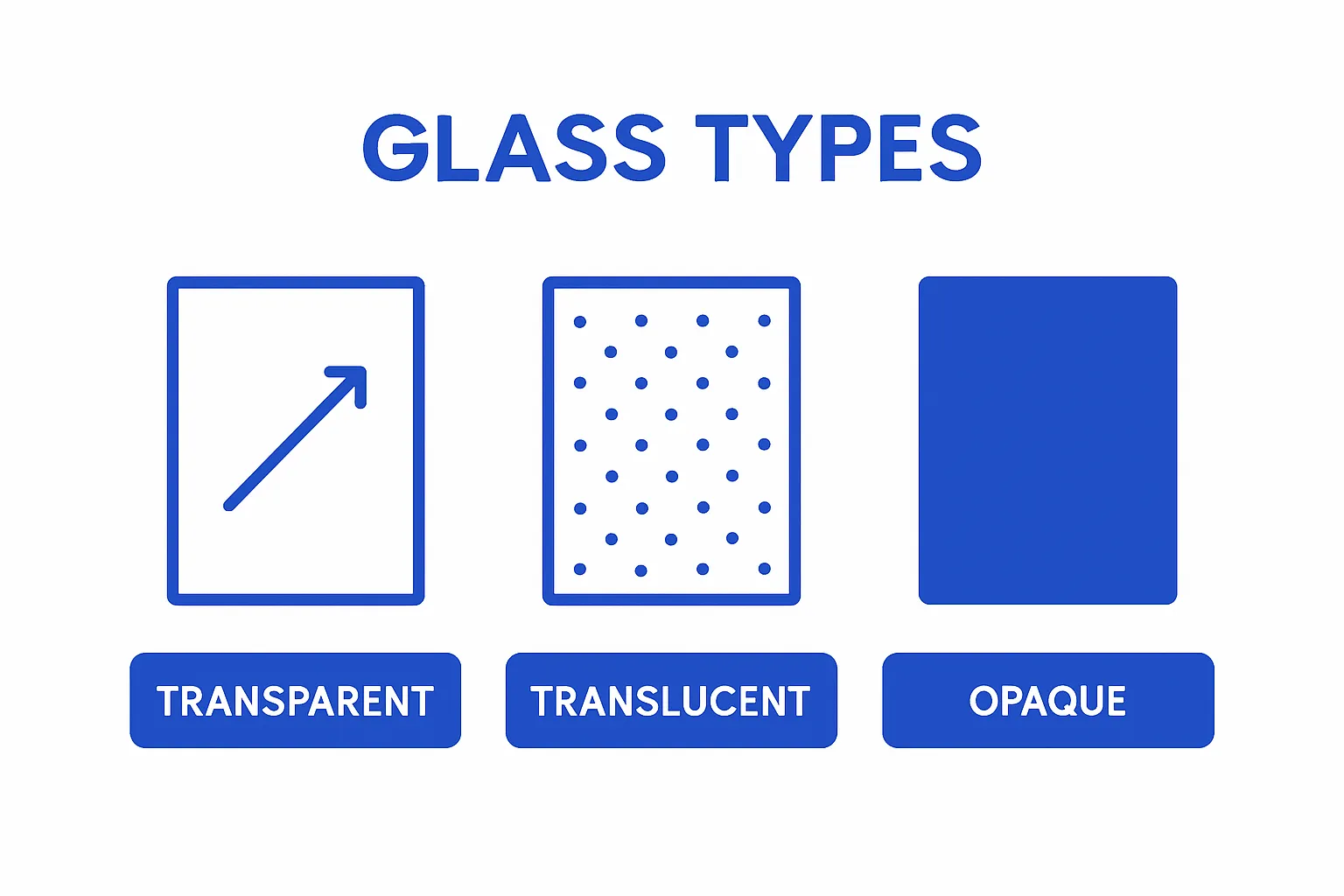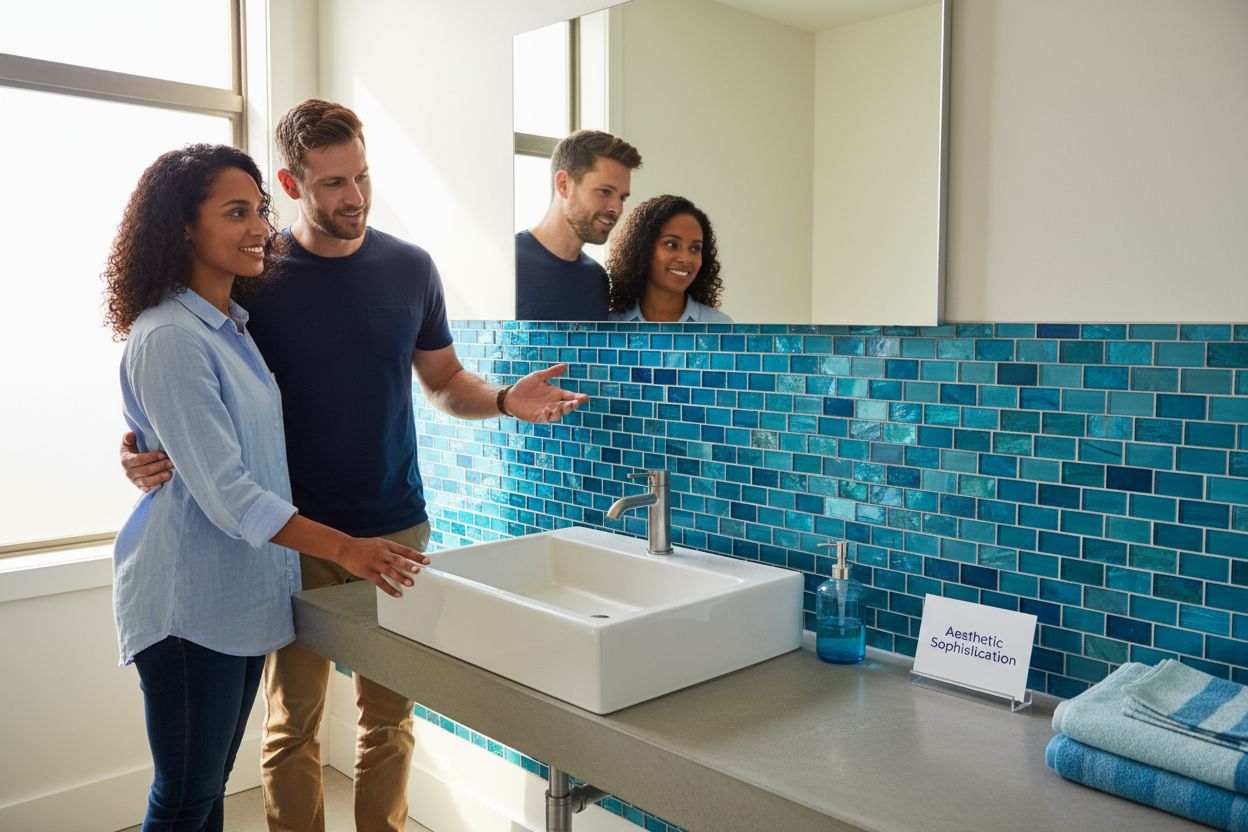What is Glass Mosaic: Understanding Its Beauty and Use
Posted by Mike Belk on Oct 17, 2025

Glass mosaic turns ordinary rooms into glowing works of art. Think about this: glass mosaics can reflect up to 90 percent more light than traditional stone tile, completely changing the mood of any space. Yet, most people only notice the colors and miss how these tiny glass pieces are actually engineered for serious strength and durability.
Table of Contents
- Defining Glass Mosaic: Materials And Techniques
- The Importance Of Glass Mosaic In Design
- Exploring The Aesthetic And Functional Benefits
- Real-World Applications Of Glass Mosaic
- Key Concepts And Innovations In Glass Mosaic
Quick Summary
| Takeaway | Explanation |
|---|---|
| Glass mosaics utilize various glass types | Performance and aesthetics depend on the use of transparent, translucent, and opaque glass fragments. |
| Light manipulation enhances visual appeal | Reflective surfaces create dynamic designs that change with light, adding depth and interaction to spaces. |
| Durability makes glass mosaics practical | Their water resistance and easy maintenance make glass mosaics ideal for high-moisture areas like kitchens and bathrooms. |
| Sustainable practices are transforming production | Focus on recycled materials and eco-friendly methods is becoming standard in modern glass mosaic creation. |
| Precision technologies enable intricate designs | Advanced manufacturing allows for hyper-detailed creations, expanding the creative possibilities in glass mosaic art. |
Defining Glass Mosaic: Materials and Techniques
Glass mosaic represents an intricate art form transforming small glass pieces into stunning visual compositions. These delicate arrangements combine color, texture, and light to create mesmerizing designs across various applications. Understanding what glass mosaic entails requires exploring its fundamental materials, creative techniques, and unique characteristics.
Glass Material Composition
Glass mosaics are crafted from specialized glass fragments manufactured through precise techniques. Artisans typically utilize several glass types including transparent, translucent, and opaque glass. These glass pieces can originate from different manufacturing processes:
- Blown glass fragments
- Pressed glass sections
- Machine-cut glass segments
- Hand-crafted glass pieces
The glass selection determines the mosaic’s final appearance, with variations in color, reflectivity, and texture playing crucial roles in design aesthetics.
Below is a table summarizing the main types of glass materials used in mosaics and their defining characteristics.
| Glass Type | Description | Visual Qualities | Typical Use Cases |
|---|---|---|---|
| Transparent | Clear glass fragments | High light transmission | Accentuate depth, dramatic lighting |
| Translucent | Semi-opaque glass | Soft light diffusion | Subtle patterns, ambient effects |
| Opaque | Non-transparent colored glass | Bold color, minimal light | Strong contrast, defined patterns |
| Blown Glass | Formed by blowing molten glass | Unique shapes, air bubbles | Artisan mosaics, custom work |
| Pressed Glass | Mold-shaped glass segments | Uniform thickness, smooth | Standard tiles, repeat designs |
| Machine-cut Glass | Precisely cut by machinery | Consistent size and shape | Intricate modern patterns |
| Hand-crafted Glass | Shaped and colored by artisans | Textural, variable finishes | Custom art, signature mosaics |
 High quality glass ensures durability and consistent visual appeal across installations.
High quality glass ensures durability and consistent visual appeal across installations.
Artistic Production Techniques
Creating glass mosaics involves meticulous craftsmanship and specialized techniques. Skilled artisans transform raw glass materials through processes like cutting, shaping, and arranging individual pieces. The production typically follows these primary methods:
- Direct application onto mesh backing
- Individual piece placement with precision adhesives
- Temperature-controlled glass fusion
- Intricate pattern design and layout planning
Professional glass mosaic creators understand how light interacts with different glass compositions, enabling them to create depth, dimension, and visual complexity. Learn more about advanced mosaic installation techniques to appreciate the skill required in this artistic process.
According to Glass Art Society Research, glass mosaics represent a delicate balance between artistic vision and technical precision, transforming simple glass fragments into extraordinary decorative elements that capture light and imagination.
The Importance of Glass Mosaic in Design
Glass mosaic transcends mere decorative functionality, emerging as a powerful design element that transforms spaces through visual storytelling, light manipulation, and artistic expression. Architects and interior designers leverage glass mosaic as a sophisticated medium to create immersive environments that communicate aesthetic sophistication and emotional depth.
Visual Impact and Spatial Transformation
Glass mosaic possesses unique characteristics that distinguish it from traditional design materials. Its ability to manipulate light creates dynamic visual experiences that evolve throughout different times of day. Reflective surfaces and intricate color variations enable designers to craft spaces that feel alive and interactive.
Key design attributes of glass mosaic include:
- Exceptional light reflection capabilities
- Ability to create depth and dimensionality
- Versatility across multiple design styles
- Capacity to visually expand or intimate spaces
Discover the top reasons why designers choose mosaic tiles for transforming architectural environments with unparalleled aesthetic sophistication.
Functional and Aesthetic Versatility
Beyond aesthetic appeal, glass mosaic serves multiple functional purposes in design applications. Its durability, resistance to moisture, and ease of maintenance make it an ideal material for diverse settings ranging from residential kitchens to commercial hospitality spaces.
Designers strategically utilize glass mosaic in various contexts:
- Kitchen backsplashes
- Bathroom wall treatments
- Swimming pool decorations
- Artistic accent walls
- Exterior architectural features
According to Design Trends International, glass mosaic represents a pivotal design element that bridges artistic expression with practical functionality, offering designers an unparalleled medium for creating visually compelling and emotionally resonant spaces.
Exploring the Aesthetic and Functional Benefits
Glass mosaic emerges as a sophisticated design solution that seamlessly blends aesthetic elegance with remarkable functional performance. Its unique composition allows designers and homeowners to create spaces that are not just visually stunning but also incredibly practical and enduring.
The following table outlines key aesthetic and functional benefits of glass mosaic tiles, organizing their main attributes for easy review.
| Benefit Area | Key Attribute | Explanation |
|---|---|---|
| Aesthetic | Chromatic diversity | Wide range of colors and customizable palettes |
| Aesthetic | Light manipulation | Reflects and refracts light for dynamic visual effects |
| Aesthetic | Pattern flexibility | Allows for gradients, ombrés, and artistic motifs |
| Functional | Water resistance | Impervious and ideal for high-moisture environments |
| Functional | Easy maintenance | Smooth surfaces allow for quick cleaning |
| Functional | Durability | Withstands wear, stains, and harsh chemicals |
| Functional | Mold resistance | Non-porous and resists mold/bacterial growth |
Aesthetic Sophistication
The visual language of glass mosaic speaks through intricate color palettes, light interactions, and textural complexity. Chromatic diversity enables designers to craft environments that range from subtle and understated to bold and dramatic. Each glass piece becomes a miniature prism, capturing and refracting light in ways that transform ordinary surfaces into extraordinary visual experiences.

Key aesthetic advantages include:
- Infinite color and pattern combinations
- Ability to create gradient and ombré effects
- Potential for custom artistic expressions
- Enhancing spatial perception through light manipulation
Learn more about the advantages of using mosaic glass backsplash to understand how these design elements elevate interior environments.
Functional Performance
Beyond aesthetic appeal, glass mosaic demonstrates exceptional functional characteristics that make it a preferred material for multiple applications. Its non porous surface provides significant practical benefits, particularly in high moisture environments like kitchens and bathrooms.
Critical functional properties include:
- Exceptional water and stain resistance
- Easy cleaning and maintenance
- High durability against mechanical wear
- Resistance to mold and bacterial growth
- Temperature and chemical stability
According to the Metropolitan Museum of Art’s historical research, glass mosaics have been prized throughout history not just for their beauty, but for their remarkable ability to create durable, long lasting decorative surfaces that withstand the test of time.
Real-World Applications of Glass Mosaic
Glass mosaic transcends traditional design boundaries, finding innovative applications across residential, commercial, and artistic domains. Its remarkable versatility enables creative professionals to reimagine spaces through intricate, luminous design solutions that blend functionality with extraordinary visual expression.
Architectural and Interior Design
In contemporary architectural practices, glass mosaic serves as a transformative design element that redefines spatial aesthetics. Designers strategically integrate glass mosaic to create focal points, manipulate visual perception, and introduce dynamic textural experiences within both interior and exterior environments.
Key architectural applications include:
- Feature walls in luxury residences
- Dramatic entryway and lobby installations
- Accent elements in modern office spaces
- Sculptural building facade treatments
- High end hospitality interior design
Specialized Environmental Contexts
Glass mosaic demonstrates exceptional adaptability across diverse settings, offering both aesthetic appeal and practical performance. Its resilience and design flexibility make it an ideal material for challenging environments that demand both beauty and durability.
Diverse application scenarios encompass:
- Swimming pool interior surfacing
- Bathroom and kitchen waterproof installations
- Spa and wellness center decorative elements
- Commercial restaurant and retail design
- Public art and memorial installations
Explore advanced mosaic tile installation techniques to understand the precision required in professional implementation.
According to International Design Quarterly, glass mosaic represents a pivotal design medium that bridges artistic innovation with practical architectural solutions, enabling designers to create immersive, transformative spatial experiences that engage and inspire human interaction.
Key Concepts and Innovations in Glass Mosaic
Glass mosaic continues to evolve through groundbreaking technological advancements and creative design approaches that push the boundaries of traditional artistic expression. Contemporary innovations are transforming how designers and artists conceptualize and implement glass mosaic techniques.
Technological Breakthroughs
Precision manufacturing technologies have revolutionized glass mosaic production, enabling unprecedented levels of detail and complexity. Advanced computer-assisted design systems and laser cutting techniques allow for intricate pattern development that was previously impossible. Manufacturers can now create microscopic glass fragments with millimeter-level accuracy, expanding the potential for hyper-detailed design compositions.
Significant technological innovations include:
- Digital pattern mapping technologies
- Nano-scale glass fragment production
- Computer controlled cutting and shaping mechanisms
- Advanced color stabilization processes
- Sustainable glass recycling techniques
Sustainable Design Approaches
Environmental consciousness is driving remarkable innovations in glass mosaic production. Designers and manufacturers are increasingly focusing on sustainable practices that reduce environmental impact while maintaining exceptional aesthetic quality. Recycled glass materials and eco-friendly production processes are becoming standard in contemporary glass mosaic creation.
Key sustainable design strategies encompass:
- Utilizing post-consumer recycled glass
- Developing low-energy manufacturing techniques
- Creating biodegradable adhesive systems
- Implementing circular design principles
- Reducing carbon footprint in production
Elevate your understanding of glass mosaic tile versatility and explore how cutting-edge design meets sustainable innovation.
According to Materials Research Institute, contemporary glass mosaic represents a dynamic intersection of artistic creativity, technological innovation, and environmental responsibility, signaling a profound transformation in decorative design approaches.
Bring the Beauty and Durability of Glass Mosaic Into Your Space
Are you searching for a way to elevate your next project with the artistic impact, light play, and resilience that only authentic glass mosaic can offer? Many readers inspired by the intricate patterns and luminous depth described in our article face a common frustration: how to find tiles that combine sophisticated style with the everyday functionality needed for kitchens, bathrooms, pools, and more. Navigating the options can feel overwhelming, especially when you want lasting beauty and easy maintenance.
BELK Tile makes your search easy and rewarding. Immerse yourself in our extensive tile collections designed for every vision and budget. Our high-quality glass mosaic tiles are carefully curated for consistent color, exceptional reflectivity, and reliable performance. Bring your unique ideas to life with detailed product filters, inspirational galleries, and a seamless online shopping experience. Ready to start your transformation? Visit BELK Tile’s website, explore our expert tips on the advantages of mosaic glass backsplash, and discover how easy it is to order the perfect materials for any space. Act quickly to discover limited-time offers and make your dream design a reality today.
Frequently Asked Questions
What materials are used to create glass mosaics?
Glass mosaics are typically made from various types of glass, including transparent, translucent, and opaque glass. These glass pieces can originate from blown glass, pressed glass, machine-cut segments, or hand-crafted pieces.
What are the main techniques used in glass mosaic production?
Key techniques for creating glass mosaics include direct application onto mesh backing, individual piece placement with adhesives, temperature-controlled glass fusion, and intricate pattern design and layout planning.
What makes glass mosaics suitable for both aesthetic and functional applications?
Glass mosaics are durable, water-resistant, and easy to clean, making them ideal for places like kitchens and bathrooms. Their ability to reflect light and create depth also enhances their aesthetic appeal in various design contexts.
How do light and color interact with glass mosaics in design?
Glass mosaics manipulate light in unique ways, creating dynamic visual experiences that evolve throughout the day. The variations in color and reflectivity enable designers to craft spaces that feel immersive and vibrant.



